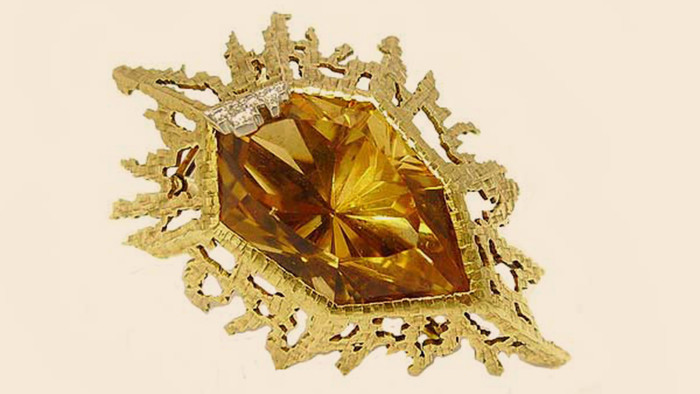Ultra-cool 1970s vibe inspires wave of must-have collections

Roula Khalaf, Editor of the FT, selects her favourite stories in this weekly newsletter.
The 1970s is achingly cool once again. In the world of fashion, Saint Laurent and Gucci are riding the crest of the 70s-inspired look.
And the world of jewellery is cashing in on the trend for nostalgia, albeit nostalgia only a few decades old.
In 2007, Daphne Lingon, senior vice-president of jewellery at Christie’s New York, identified what would be the next big thing in the market. She won a surprisingly hard-fought bidding battle for a pair of 1970s David Webb gold and white enamel ear pendants for an unidentified high-profile client for the world of fashion.
Today, her instinct has proved accurate as the market for 1970s jewellery flourishes. Yet despite this, according to Ms Lingon: “We don’t have enough [1970s] pieces for demand.”
Prices are climbing, more pieces are on the market and estimates are being smashed. A simple Bulgari gold chain necklace went for $25,000 — five times its estimate — at a sale in April held at Sotheby’s New York.
Frank Everett, sales director of jewellery at Sotheby’s New York, says: “People collecting jewellery in the 1970s are now in their 80s and 90s and are selling now. And there are more estates with 1970s pieces.”
He cites two big private collections in the company’s forthcoming December sale as an example, including an 18-carat gold and carved jade David Webb necklace with detachable pendant estimated at $80,000-$120,000.
Fashion has shown jewellery the way. Hedi Slimane, creative director of Saint Laurent (which made its name in the 1970s) has doubled the brand’s sales revenue from €353m in 2011 to €707m in 2014, thanks to his sellout 1970s rock ’n’ roll collections.
And now there is Gucci’s new creative director, Alessandro Michele, who has overhauled the company — and influenced the industry — with his heavily 1970s-inspired debut collections, which have helped reinvigorate the brand. In July, Gucci announced a 4.6 per cent jump in second-quarter sales, after a 7.9 per cent drop in first-quarter sales.
“Everyone loves the 1970s and the idea of being so cool yet so laid back,” says Justin O’Shea, buying director for luxury e-retailer Mytheresa.com. “The 1970s spirit is unbridled and it provides a feeling of pure happiness, which resonates with the end consumer, whether fashion or high jewellery.”
While 1970s jewellery by Bulgari, David Webb, Van Cleef & Arpels and other big names make the highest prices, the market for independent 1970s designers such as Andrew Grima and John Donald is growing, too.
Indeed, according to Daniel Struyf, Bonhams’ new international jewellery director, there was more craftsmanship in 1970s jewellery than in today’s pieces. Little wonder a Grima grey-blue sapphire and diamond square-cut ring in Bonhams’ fine jewellery sale in London next month is estimated at £500,000- £700,000.
London gallerist Louisa Guinness, who launched LG Treasures in May focusing on rare 1970s (and 1960s) jewels, says these pieces have widened the pool of traditional jewellery collectors. “The designs are mini artworks so they appeal to collectors who like design rather than rocks or gold,” she says.
More women in their 30s to 50s are purchasing these pieces, too — to wear as well as invest. Catherine McKenna, co-founder of fine antique and period jewellers McKenna & Co, says: “They want an exclusive piece like a Kutchinsky instead of the same Rolex as everyone else.”
According to Jon King, senior vice-president of product and store design at Tiffany & Co, the yellow gold that characterises 1970s jewellery makes it today’s canny investment, thanks to a better understanding of assets and investments. Tiffany has recently plundered its design archive for the first time, using its 1970s Blue Book catalogue for an eight-piece capsule collection with Dover Street Market including diamond and tsavorite gold earrings adapted from a 1973 cufflinks and stud set. “The 1970s broadens our international appeal,” says Mr King.
“Nineteen seventies jewellery is still relatively inexpensive compared to other popular periods such as Art Deco or Georgian,” says Sam Loxton, manager of Lucas Rarities, a London-based jeweller specialising in the 1910s to the 1970s, who spoke on 1970s jewellery at September’s Lapada art and antiques fair. “Prices [for 1970s pieces] tend to be under £50,000, while I sold a Cartier Art Deco diamond sautoir for £125,000 at Art Antiques London in June and a pair of Georgian diamond drop earrings for £145,000 in July,” he says.
Cristina Miller, North American head of dealer relations at online marketplace 1stdibs, says the high visibility of 1970s jewellery online is fuelling the market — whether on its website or the auction house e-catalogue.
“The big, bold designs and unmissable yellow gold are easier to see online than say the intricate Art Deco looks which are harder to see even with a zoom,” she says.
The deep-pocketed big brands are also driving the market as they buy back their archive to showcase in retrospectives and bolster their collections.
Van Cleef & Arpels is hoovering up its 1970s pieces as “if I wait I won’t find anything on the second-hand market”, says Catherine Cariou, the company’s heritage director. And Bulgari is showcasing its first coin collections, multi-gem sautoirs and other 1970s pieces in its Art of Bulgari show at the Tokyo National Museum.
“Everywhere we expose the brand, we show these [1970s] pieces to bring desirability to the brand and to convince clients to go for a high jewellery piece, particularly those clients from China and south east Asia” says Vincent Reynes, Bulgari’s UK managing director.
With the 1970s look still vibrating across the spring/summer 2016 catwalks, boho jewels look set for a glittering future.
Comments